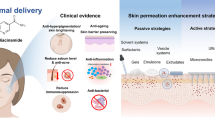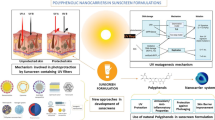Abstract
A correlation of the levels of epidermal protein kinase C (PKC) isozymes, steady state levels of ornithine decarboxylase (ODC) mRNA, and ODC antizyme with the induction of ornithine decarboxylase (ODC) activity by a second repeat 12-O-tetradecanoylphorbol-13-acetate (TPA) treatment to mouse skin was determined. A single application of TPA to female CD-1 mouse skin leads to a dramatic induction of ODC activity (≈3 nmol CO2/60 min/mg protein) which peaks at about 5 h after treatment. However, a superinduction of ODC activity (≈13 CO2/60 min/mg protein) is observed upon the second TPA application at 48 or 72 h after the first TPA treatment. Prior application of a tumor initiating dose of 7,12-dimethylbenz[a]anthracine to mouse skin did not influence the degree of induction of ODC by a repeat TPA treatment. Western Blot analyses using antibodies specific to PKC α, β, γ, ɛ and s indicate detectable levels of PKC α, β, δ and ε in mouse epidermal extracts. A time course of the effects of a single topical application of 20 nmol of TPA to the mouse skin indicate that none of PKC isozymes (α, β, γ, δ and ɛ) were completely downregulated at times (72 h) when ODC was overinduced by TPA. TPA-induced steady state levels of ODC mRNA did not correlate with the degree of superinduction of ODC activity by TPA. The second TPA treatment, 72 h after the first TPA treatment, which leads to superinduction of ODC activity did not decrease the levels of the ODC-antizyme. The results indicate that superinduction of mouse epidermal ODC activity is regulated in part post-transcriptionally and may not be the result of either a loss of PKC isoform(s) or a decrease in the levels of ODC antizyme.
Similar content being viewed by others
Abbreviations
- TPA:
-
12-0-tetradecanoylphorbol-l3-acetate
- PKC:
-
protein kinase C
- ODC:
-
ornithine decarboxylase
- IPTG:
-
Isopropyl β-D-thiogalactopyranoside
References
Boutwell RK: The function and mechanism of promoters of carcinogenesis. CRC Crit Rev Toxicol 2: 419–443, 1974
Verma AK, Boutwell RK: Effects of dose and duration of treatment with the tumor promoting agent, 12–0-tetradecanoylphorbol-13acetate, on mouse skin carcinogenesis. Carcinogenesis 1: 271–276, 1980
Verma AK, Boutwell RK: Inhibition of carcinogenesis by inhibitors of putrescine biosynthesis. In: P.P. McCann, A.E. Pegg, A. Sjoerdsma (eds) Inhibition of Polyamine Metabolism: Biological Significance and Basis for New Therapies. Academic Press, Inc., Orlando, 1987, pp 249–258
Fujiki H, Suganuma M, Suniri H, Yoshizawa S, Takagi K, Sassa T, Uda N, Wakamatsu K, Yamada K, Yasumoto T, Kato Y, Fusetani N, Hashimoto K, Sugimura T: New tumor promoters from marine sources: the okadaic acid class. In: S. Natori, K. Hashimoto and Y. Ueno (eds). Mycrotoxins and Phycotoxins. Elsevier Science Publishers BV, Amsterdam, Netherlands, 1989, pp 453–460
Slaga TJ, Fischer SM, Nelson K, Gleason GL: Studies on the mechanism of skin tumor promotion: evidence for several stages in promotion. Proc Natl Acad Sci USA 77: 3659–3663, 1980
Furstenberger G, Kinzel V, Schwartz M, Marks F: Partial inversion of the initiation-promotion sequence of multistage tumorigenesis in the skin of NMR mice. Science 230: 76–78, 1985
Verma AK: Mouse skin carcinogenesis. In: H.I. Maihach and N.J. Lowe (eds). Models in Dermatology. Karger, New York, 1985, 313–321
O'Brien TG: The induction of ornithine decarboxylase as an early, possibly obligatory event in mouse skin carcinogenesis. Cancer Res 36: 2644–2653, 1976
Verma AK: Ornithine decarboxylase, a possible target for human cancer prevention. In: Steele, Stoner, Bone and Kelloff (eds). Cellular and Molecular Targets for Chemoprevention. CRC Press, Inc, Florida, 1992, pp 207–222
Halmekyto M, Syrjanen K, Janne J, Alhonen L: Enhanced papilloma formation in response to skin tumor promotion in transgenic mice overexpressing the human ornithine decarboxylase gene. Biochem Biophys Res Commun 187: 493–497, 1992
Megosh L, Gilmour SK, Rosson D, Soler AP, Blessing M, Sawicki JA, O'Brien TG: Increased frequency of spontaneous skin tumors in transgenic mice which overexpress ornithine decarboxylase. Cancer Res 55: 4205–4209, 1995
Pegg AE: Recent advances in the biochemistry of polyamines in eukaryotes. Biochem J: 234: 249–269, 1986
Hsieh JT, Verma AK: Expression of human chromosome 2 ornithine decarboxylase gene in ornithine decarboxylase-deficient Chinese hamster ovary cells. Cancer Res 50: 2239–2244, 1990
Verma AK, Erickson D, Dolnick BJ: Increased mouse epidermal ornithine decarboxylase activity by the tumour promoter 12–0-tetradecanoylphorbol-13-acetate involves increased amounts of both enzyme protein and messenger RNA. Biochem J 237: 297–300, 1986
Gilmour SK, Verma AK, Madara T, O'Brien TG: Regulation of ornithine decarboxylase gene expression in mouse epidermis and epidermal tumors during two-stage tumorigenesis. Cancer Res 47: 1221–1225, 1987
Verma AK, Pong RC, Erickson D: Involvement of protein kinase C activation in ornithine decarboxylase gene expression in primary culture of new born mouse epidermal cells and in skin tumor promotion by 12–0-tetradecanoylphorbol-13-acetate. Cancer Res 47: 6149–6155, 1986
Verma AK: Inhibition of tumor promoter 12–0-tetradecanoylphorbol-13acetate-induced synthesis of epidermal ornithine decarboxylase messenger RNA and diacylglycerol-promoted mouse skin tumor formation by retinoic acid. Cancer Res 48: 2168–2173, 1988
Hsieh JT, Verma AK: Involvement of protein kinase C in transcriptional regulation of ornithine decaboxylase gene expression by 12–0-tetradecanoylphorbol-l3-acetate in the T24 human bladder carcinoma cells. Arch Biochem Biophys 262: 326–336, 1988
Hsieh JT, Verma AK: Lack of a role of DNA methylation in tumor promoter 12–0-tetradecanoylphorbol-13-acetate-induced synthesis of ornithine decarboxylase messenger RNA in T24 cells. Cancer Res 49: 4251–4257, 1989
Kim YJ, Pan H, Verma AK: Non-AP-1 tumor promoter 12–0-tetradecanoylphorbol-13-acetate responsive sequences in human ornithine decarboxylase gene. Mol Carcinogenes 10: 169–179, 1994
Nishizuka Y: Intracellular signaling by hydrolysis of phospholipids and activation of protein kinase C. Science 258: 607–614, 1993
Akita Y, Ohno S, Konno Y, Yano A, Suzuki K: Expression and properties of two distinct classes of the phorbol ester receptor family, four conventional protein kinase C types, and a novel protein kinase C. J Biol Chem 265: 354–362, 1990
Verma AK: Protein kinase C activator diacylglycerol: a potent stage II mouse skin tumor promoter. Cancer Res 48: 1736–1739, 1988
Smart RC, Mills KJ, Hansen LA, Conney AH: Synthetic lipid second messenger sn-1,2-didecanoylglycerol: a complete tumor promoter in mouse skin. Cancer Res 49: 4455–4458, 1989
Tseng CP, Kim Y-J, Ravindra K, Verma AK: Involvement of protein kinase C in the transcriptional regulation of 12–0-tetradecanoylphorbol-13-acetate-inducible genes modulated by AP- 1 or non-AP1 transacting factors. Carcinogenesis 15: 707–711, 1994
Fischer SM, Jasheway DW, Klann RC et al.: Correlation of phorbol ester promotion in the resistant C57BL/6J mouse with sustained hyperplasia but not ornithine decarboxylase or protein kinase C. Cancer Res 49: 6693–6699, 1989
Mills KJ, Smart RC: Comparison of epidermal protein kinase C activity, ornithine decarboxylase induction and DNA synthesis stimulated by TPA or diactanoylglycerol in mouse strains with differing susceptibility to TPA-induced tumor promotion. Carcinogenesis 10: 833–838, 1989
Fournier A, Murray AW: Application of phorbol ester to mouse skin causes a rapid and sustained loss of protein kinase C. Nature 330: 767–769, 1987
Murakami Y, Hayashi S: Role of antizyme in degradation of ornithine decarboxylase in HTC cells. Biochem J 226: 893–896, 1985
Murakami Y, Marumo M, Hayashi S: Ornithine decarboxylase antizyme in kidneys of male and female mice. Biochem J 254: 367–372, 1988
McConlogue L, Gupta M, Wu L, Coffino P: Molecular cloning and expression of the mouse ornithine decarboxylase gene. Proc Natl Acad Sci USA 81: 540–544, 1984
Lowry OH, Rosenbrough NJ, Farr AL, Randall RJ: Protein measurement with the folin phenol reagent. J Biol Chem, 193: 265–275, 1951
Inoue H, Mizutani A: A new method for isolation of polyamines from animal tissues. Anal Biochem 56: 408–416, 1973
Heby O, Sarna GP, Marton LJ, Omine M, Perry S, Russell DH: Polyamine content of AKR leukemic cells in relation to the cell cycle. Cancer Res 33: 2959–2964, 1973
Burton KA: Study ofthe conditions and mechanisms of the diphenylamine reaction for the colorimetric estimation of deoxyribonucleic acid. Biochem J 62: 315–323, 1956
Tseng C-P, Verma AK: Functional expression and characterization of mouse epitope tag-protein kinase C isoforms, α, (βI, βII, 7, δ and ɛ. Gene (in press)
Towbin H, Staehelin T, Gordon J: Electrophoretic transfer of proteins from polyacrylamide gels to nitrocellulose sheets: Procedure and some applications. Proc Natl Acad Sci USA 76: 4350–1354, 1979
Chomezynski P, Sacchi N: Single step method of RNA isolation by acid guanidinium thiocyanate phenol-chloroform extraction. Anal Biochem 162: 156–159, 1987
Feinstein SC, Dana SL, McConlogue L, Shooter EM, Coffino P: Nerve growth factor rapidly induces ornithine decarboxylase mRNA in PC 12 rat pheochromocytoma cells. Proc Natl Acad Sci USA 82: 5761–5765, 1985
Kafatos FC, Jones CW, Efstratiadis, A: Determination of nucleic acid sequence homologies and relative concentration by a dot hybridization procedure. Nucleic Acids Res 7: 1541–1552, 1979
Cheley S, Anderson R: A reproducible microanalytical method for the detection of specific RNA sequences by dot-blot hybridization. Anal Biochem, 137: 15–19, 1984
Thomas PS: Hybridization of denatured RNA and small DNA fragments transferred to nitrocellulose. Proc Natl Acad Sci USA 77: 5201–5205, 1980
Dolnick BJ, Bertino JR: Multiple messenger mRNAs for dihydrofolate reductase. Arch Biochem Biophys 210: 691–697, 1981
Takigawa M, Simsima RC, Boutwell RK: The difference between the effects of single and double applications of 12–0-tetradecanoylphorbol13-acetate, a potent tumor promoter, on polyamine metabolism and nucleic acid synthesis in mouse epidermis. Carcinogenesis 4: 5–8, 1983
Verma AK, Shapas BG, Rice HM, Boutwell RK: Correlation of the inhibition by retinoids of tumor promoter-induced mouse epidermal ornithine decarboxylase activity and of skin tumor promotion. Cancer Res 39: 419–125, 1979
Koza RA, Megosh LC, Palmieri M, O'Brien TG: Constitutively elevated levels of ornithine and polyamines in mouse epidermal papillomas. Carcinogenesis 12: 1619–1625, 1991
Hirabayashi N, Warren BS, Wang XJ, Peterson-Marht S, Beltren L, Davis MM, Ashendel CL, DiGiovanni J: Partial characterization of epidermal protein kinase C in mouse sensitive or resistant to phorbol ester. MolCarcinogenesis 3: 171–180, 1990
Wang XJ, Warren BS, Beltran LM, Fosmire SP, DiGiovanni J: Further identification of protein kinase C isozymes in mouse epidermis. J Cancer Res Clin Onc 119: 278–287, 1993
Raick AN: Cell differentiation and tumor-promoting action in skin carcinogenesis. Cancer Res 34: 2915–2925, 1974
Raick AN: Ultrastructural, histological, and biochemical alterations produced by 12–0-tetradecanoylphorbol-13-acetate on mouse epidermis and their relevance to skin tumor promotion. Cancer Res 33: 269–280, 1973
Thomas T, Thomas TJ: Regulation of cyclin B1 by estradiol and polyamines in MCF-7 breast cancer cells. Cancer Res 54: 1077–1084, 1994
Pohjanpelto P, Nordling S, Knuutila S: Flow cytometric analysis of the cell cycle in polyamine-depleted cells. Cytometry 16: 331–338, 1994
Dekker LV, Parker PJ: Protein kinase C — a question of specificity. TIBS 19: 73–77, 1994
Weinstein IB: Protein kinase C and signal transduction: a role in cancer prevention and treatment. Adv Oncology 9: 3–9, 1994
Wang X-J, Warren, BS, Rupp T, Beltran LM, DiGiovanni J: Loss of mouse epidermal protein kinase C isozyme activities following treatment with phorbol ester and non-phorbol ester tumor promoters. Carcinogenesis 15: 2795–2803, 1994
Verma AK: The enzyme-activated irreversible inhibitor of ornithine decarboxylase, DL-α-difluoromethylornithine: A chemopreventive agent. Prevent Med 18: 646–652, 1989
Halmekyto M, Syrjanen K, Janne J, Ahonen L: Enhanced papilloma formation in response to skin tumor promotion in transgenic mice overexpressing the human ornithine decarboxylase gene. Biochem Biophys Res Commun 187: 493–497, 1992
Robertson FM, Gilmour SK, Conney AH, Huang MT, Beavis AJ, Laskin JD, Heitala OA, O'Brien TG: Identification of epidermal cell subpopulation with increased ornithine decarboxylase activity follow ing treatment of murine epidermis with 12–0-tetradecanoylphorbol-13-acetate. Cancer Res 50: 4741–4746, 1990
Author information
Authors and Affiliations
Additional information
The work was supported by the USPHS grant CA35368 from the National Institute of Health.
Rights and permissions
About this article
Cite this article
Verma, A., Hsiao, K., Ahrens, H. et al. Superinduction of mouse epidermal ornithine decarboxylase activity by repeated 12-0-tetradecanoylphorbol-13-acetate treatments. Mol Cell Biochem 155, 139–151 (1996). https://doi.org/10.1007/BF00229311
Received:
Accepted:
Issue Date:
DOI: https://doi.org/10.1007/BF00229311




